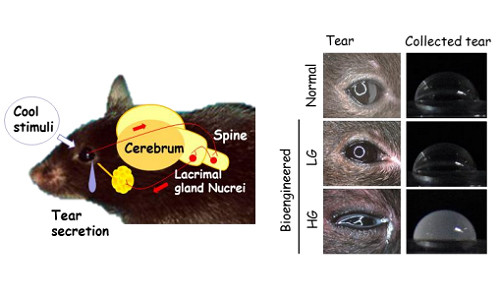A research group headed by Professor Takashi Tsuji of Tokyo University of Science have successfully regenerated fully functional bioengineered salivary and lacrimal (tear) glands. The results signify a substantial advance in the development of next generation organ replacement regenerative therapies. The results are published in the scientific journal Nature Communications.

stimulation. Credits: tsuji-lab
Organ replacement regenerative therapy has been proposed as having the potential to enable the replacement of organs that have been damaged by disease, injury or ageing. A research group led by Professor Takashi Tsuji (Professor in the Research Institute for Science and Technology, Tokyo University of Science, and Director of Organ Technologies Inc.) has provided a proof-of-concept for bioengineered organ replacement as the next step for regenerative therapy.
For the salivary glands, Dr. Tsuji’s research group (M. Ogawa et al.) reports the fully functional regeneration of a salivary gland that reproduces the morphogenesis induced by reciprocal epithelial and mesenchymal interactions through the orthotopic transplantation of a bioengineered salivary gland germ as a regenerative organ replacement therapy. The bioengineered germ developed into a mature gland through acinar formations with the myoepithelium and innervation. The bioengineered submandibular gland produced saliva in response to the administration of pilocarpine and gustatory stimulation by citrate, protected against oral bacterial infection and restored normal swallowing in a salivary gland defect mouse model. Thus, this study provides a proof-of-concept for bioengineered salivary gland regeneration as a potential treatment for xerostomia.
For the lacrimal (tear) glands, Dr. Tsuji’s research group (M. Hirayama et al.,) reports the successful orthotopic transplantation of a bioengineered lacrimal gland germ into an adult extra-orbital lacrimal gland defect model mouse, which mimics the corneal epithelial damage caused by lacrimal gland dysfunction. The bioengineered lacrimal gland germ and harderian gland germ both developed in vivo and achieved sufficient physiological functionality, including tear production in response to nervous stimulation and ocular surface protection. This study demonstrates the potential for bioengineered organ replacement to functionally restore the lacrimal gland.
Story Source:
The above story is based on materials provided by ACN Newswire.
More information:
Prof. Takashi Tsuji, PhD
Research Institute for Science and Technology
Tokyo University of Science
Noda, Chiba, 278-8510, JAPAN
E-mail: [email protected]
TEL: +81-4-7122-9711
FAX: +81-4-7122-1499
E-mail: [email protected]; [email protected]
URL: http://www.tsuji-lab.com/





